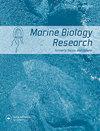Investigating the capture mechanism of scavenging gastropods in hanging-net fisheries
IF 1.2
4区 生物学
Q4 ECOLOGY
引用次数: 1
Abstract
ABSTRACTThe current study aimed to elucidate the capture mechanism of B. brandaris and H. trunculus in two métiers of the Greek small-scale fisheries (SSF) that use trammel. The commercial and discarded catch from three commercial SSF boats was recorded in parallel to in-situ SCUBA diving observations and video analyses of the entangled catch at net retrieval. The abundance of gastropods in the nets was correlated with the abundance of captured fish in both métiers. This correlation was undoubtedly caused by the scavenging activity of gastropods on organisms captured in the lower portion of the net, such as combers, wrasses, and cuttlefish. Underwater observations revealed that the number of scavengers per fish increased gradually with the degree of fish consumption, whereas on-deck observations revealed that the foraging groups became malformed as soon as the flesh consumption was complete, as evidenced by the presence of fish bones in the absence of scavengers. Only a small percentage of the gastropods in the catch became entangled on the net, and that the majority of the gastropods were carried on deck by attaching to their entangled prey. The current study provided a clear explanation of the capture mechanism of the two muricids, as well as critical knowledge for their conservation.KEYWORDS: small-scale fisheriestrammel netsmuricidsdiscardsMediterranean AcknowledgmentsThe current study was carried out as part of the ‘ENVIRO_NETS: mitigating the environmental impact of trammel nets’ project, which was funded by the Greek Operational Programme for Fisheries and Sea (2014–2020), under the call for ‘innovation related to the conservation of marine living resources’ [MIS 5068822]. The authors would like to thank Chryssanthi Antoniadou and Katerina Charitonidou for their assistance with laboratory analysis and scientific diving and Maria Garagouni for curating the database. Konstantina Vei and Dimitris Pavlidis are thanked for their assistance at experimental fishing trials. A special thanks goes to the collaborating fishers for sharing their knowledge and insights throughout all stages of this work.Disclosure statementNo potential conflict of interest was reported by the author(s).Additional informationFundingThis work was supported by Greek Operational Programme for Fisheries and Sea (2014-2020),: [Grant Number MIS 5068822].吊网渔业中食腐腹足动物捕获机制的研究
摘要本研究旨在探讨在希腊小规模渔业(SSF)中,使用诱捕器的两种渡口捕获布氏白僵菌(B. brandaris)和小圆僵菌(H. trunculus)的机理。同时记录了三艘商业SSF渔船的商业和废弃渔获物,以及现场水肺潜水观察和回收渔网时缠结渔获物的视频分析。网中腹足类动物的丰度与两个区域捕获的鱼的丰度相关。毫无疑问,这种相关性是由于腹足类动物对网底捕获的生物(如梳鱼、濑鱼和墨鱼)的清除活动造成的。水下观察显示,每条鱼的食腐动物数量随着鱼的消耗程度逐渐增加,而甲板上的观察显示,一旦肉的消耗完成,觅食群体就会变得畸形,这一点可以通过在没有食腐动物的情况下出现鱼骨来证明。捕获的腹足类动物中只有一小部分被网缠住,大多数腹足类动物是通过附着在被缠住的猎物上被带到甲板上的。本研究为这两种杀菌剂的捕获机制提供了清晰的解释,并为它们的保护提供了重要的知识。当前的研究是作为“ENVIRO_NETS:减轻拉梅网对环境的影响”项目的一部分进行的,该项目由希腊渔业和海洋业务计划(2014-2020)资助,呼吁“与海洋生物资源保护相关的创新”[MIS 5068822]。作者要感谢Chryssanthi Antoniadou和Katerina Charitonidou在实验室分析和科学潜水方面提供的帮助,并感谢Maria Garagouni管理数据库。感谢Konstantina Vei和Dimitris Pavlidis对实验性捕鱼试验的协助。特别感谢合作的渔民在这项工作的各个阶段分享他们的知识和见解。披露声明作者未报告潜在的利益冲突。本研究由希腊渔业和海洋业务计划(2014-2020)资助,[资助号MIS 5068822]。
本文章由计算机程序翻译,如有差异,请以英文原文为准。
求助全文
约1分钟内获得全文
求助全文
来源期刊

Marine Biology Research
生物-海洋与淡水生物学
CiteScore
2.10
自引率
0.00%
发文量
55
审稿时长
6-12 weeks
期刊介绍:
Marine Biology Research (MBRJ) provides a worldwide forum for key information, ideas and discussion on all areas of marine biology and biological oceanography. Founded in 2005 as a merger of two Scandinavian journals, Sarsia and Ophelia, MBRJ is based today at the Institute of Marine Research, Bergen, Norway. The Journal’s scope encompasses basic and applied research from all oceans and marine habitats and on all marine organisms, the main criterium for acceptance being quality.
 求助内容:
求助内容: 应助结果提醒方式:
应助结果提醒方式:


